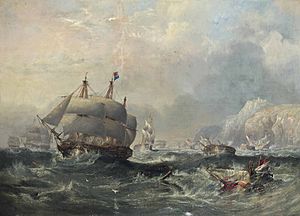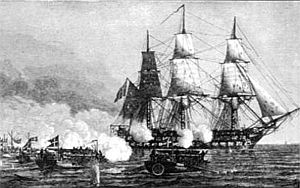HMS Africa (1781) facts for kids

HMS Africa
|
|
Quick facts for kids History |
|
|---|---|
| Name | HMS Africa |
| Ordered | 11 February 1778 |
| Builder | Barnard, Deptford |
| Laid down | 2 March 1778 |
| Launched | 11 April 1781 |
| Fate | Broken up, May 1814 |
| Notes |
|
| General characteristics | |
| Class and type | Inflexible-class ship of the line |
| Tons burthen | 1,4144⁄94 (bm) |
| Length |
|
| Beam | 44 ft 9 in (13.6 m) |
| Depth of hold | 18 ft 1 in (5.5 m) |
| Propulsion | Sails |
| Sail plan | Full-rigged ship |
| Armament |
|
HMS Africa was a large sailing warship of the Royal Navy. It was called a "ship of the line" because it was strong enough to fight in the main battle line. Africa had 64 guns and was launched on April 11, 1781. It was built by William Barnard in Deptford, England.
Contents
Building a Warship: HMS Africa
Africa was designed by John Williams. It belonged to the Inflexible-class of ships. These ships were a bit smaller than the 74-gun warships of the time.
The order to build Africa was given on February 11, 1778. Its construction began on March 2, 1778. The ship was finished and ready for sea in July 1781.
Interestingly, the first ship of this class, HMS Inflexible, didn't sail very well. Because of this, the Royal Navy decided not to build any more ships of this design. However, Africa and its sister ships were already being built, so they were completed as planned.
HMS Africa's Adventures at Sea
Fighting in the American Revolutionary War
Africa was first put into service in March 1781. Captain Thomas Newnham was its first commander. In 1782, Captain Robert McDowell took command. He sailed Africa to the East Indies.
Africa fought in the Battle of Cuddalore on June 20, 1783. This battle was not successful for the British. After the American Revolutionary War ended, Africa returned to Britain. It was taken out of service in May 1784.
Service During the French Revolutionary Wars
Africa was brought back into service in November 1793. This was for the French Revolutionary Wars. Captain Roddam Home commanded the ship. In 1794, it sailed to Nova Scotia.
Later, Africa moved to the Jamaica Station. It took part in an attack on Leogane, Haiti, in March 1796. Africa and another ship, HMS Leviathan, were badly damaged by shore cannons. The attack had to be called off.
In 1798, Africa was changed into a hospital ship. It helped care for sick and wounded sailors.
The Napoleonic Wars and Trafalgar

When the Napoleonic Wars began, Africa was rebuilt as a 64-gun warship. This work was finished in July 1805. Captain Henry Digby became its new commander.
Africa was present at the famous Battle of Trafalgar on October 21, 1805. It had been separated from the main British fleet. So, Africa arrived from a different direction. Captain Digby did not know Admiral Horatio Nelson's battle plan.
Instead of joining the main attack, Africa sailed alongside the enemy ships. It fired its cannons at them as it passed. In this battle, Africa had 18 men killed and 44 wounded.
The Gunboat War and Danish Attack
During the Gunboat War, Captain John Barrett commanded Africa. On October 15, 1808, Africa was protecting 137 merchant ships. They were sailing in the Baltic Sea.
On October 20, they anchored near Malmö. A group of 25 Danish gunboats and 7 armed launches appeared. They had about 70 heavy cannons and 1600 men. Africa sailed to stop them.
The wind died down, and Africa could not move. The Danish gunboats surrounded Africa. They fired from angles where Africa's cannons could not easily reach them. The battle lasted for hours.
When night fell, the fighting stopped. Africa was badly damaged. It had 9 men killed and 51 wounded, including Captain Barrett. The ship had to go for repairs. However, the merchant ships it was protecting managed to reach Britain safely.
In 1810, George Frederick Ryves commanded Africa. He brought a large group of ships home through very bad weather.
War of 1812
Under Captain John Bastard, Africa was part of a British group of ships. They chased the American ship USS Constitution during the War of 1812. However, they could not catch it.
End of Service
HMS Africa was taken apart in May 1814. This happened at Portsmouth, ending its long service.


